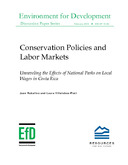Conservation policies and labor markets: unraveling the effects of national parks on local wages in Costa Rica

View/
Date
2010Author
Environment for Development
Resources for the Future, Washington, DC (EUA)
Robalino, J
Villalobos, L
Type
Artículo
Metadata
Show full item recordDescription
Incluyen 24 referencias bibliográficas.
Abstract
Despite the global environmental benefits of increasing the amount of protected areas, how these conservation policies affect the well-being of nearby individuals is still under debate. Using household surveys with highly disaggregated geographic references, we explored how national parks affect local wages in Costa Rica and how these effects vary within different areas of a park and among different social groups. We found that a park’s effects on wages vary according to economic activity and proximity to the entrance of the park. Wages close to parks are higher only for people living near tourist entrances. Workers close to entrances are not only employed in higher-paid activities (non-agricultural activities) but also receive higher wages for these activities. Agricultural workers, however, are never better off close to parks (neither close to or far from the entrances). Also, workers close to parks but far away from tourist entrances earn similar or lower wages than comparable workers far away from parks. Our results are robust to different econometric approaches (OLS and matching techniques). The location of national park entrances and the possibility that agricultural workers can switch to higher-paid service activities near tourist entrances may be important tools for helping local workers take advantage of the economic benefits of protected areas
Keywords
Publisher
Environment for Development
Is part of
Discussion paper series (EfD);
URI (Permanet link to cite or share this item)
https://repositorio.catie.ac.cr/handle/11554/10757Collections
- Publicaciones y documentos [4419]

